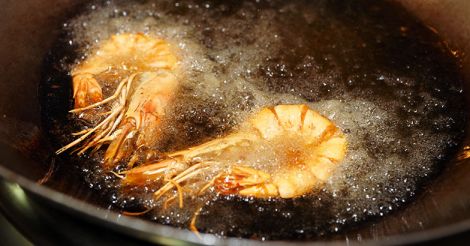It is said that man is the only animal that consumes oil as part of diet. The rest of the animal kingdom survives on raw food: whether it is of plant or animal origin.
Fat is an essential part of our diet, and cooking oils have been the focus of much debate in the past century. There is a large amount of information out there claiming ‘scientifically proven’ superiority of one cooking oil over another – unfortunately a lot of such evidence is of poor quality.
Also read: Everyday Health | Thinking of the worst-case-scenario each time?
This article is written after carefully filtering out commercially biased and promotional information. Being a complex topic, it is formatted into six segments for ease of understanding:
1. Fat and its role in the body
2. Explanation of the common terms
3. The indisputable scientific facts about cooking oil
4. Controversial but pertinent topics
5. Adulteration and harmful recycling of oil
6. Conclusions
The term ‘fat’ is loathed by society at large. However, fat plays a critically important part in keeping our body healthy – a role that gets rarely acknowledged.
What are some of the functions of fat in the human body?
1. Each cell in our body is covered by a specialized membrane composed mostly of fat.
2. Fat forms a major portion of organs such as the brain and nerves.
3. Fat is an excellent fuel, not just for humans but for the animal kingdom at large. Among all fuels available to the body, it gives the maximum mileage: a teaspoon of oil gives us 40 K cal while a teaspoon of sugar gives us only 15. Thus, for every gram of weight, fat generates more than twice the energy. Being relatively lighter to carry around, fat is our preferred energy reserve - which we can rely on during times of starvation or illness.
4. Fat adds taste to our diet, and unlike sugar, helps us feel full after a meal and also assists with absorbing certain vitamins.
Also check: Everyday Health | Information overload: how it can make our brain freeze, even lower our IQ
What exactly is fat made up of?
Fat is composed of carbon, hydrogen and oxygen, but in different proportions and structure than carbohydrates and proteins. It is estimated that there are thousands of types of fat molecules, of which only a few are commonly discussed, such as cholesterol, phospholipids and triglycerides. Oils are fats that are liquid at room temperature.
Most of the stored fat in the body is in the form of triglycerides - each having a backbone of glycerol to which three fatty acids are attached. Phospholipids are similar to triglycerides, except that one fatty acid is replaced by a phosphate group.
Fatty acids have chains of carbon atoms, of varying length, thus being called short, medium and long-chain fatty acids. They are over forty in number and found in vegetable oils, nuts, seeds, animal products as well as in fish.
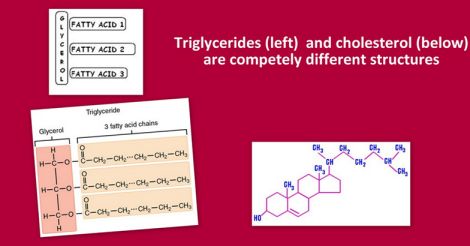 Triglycerides are the basic unit of fat in diet. They are made of three fatty acids attached to a glycerol molecule. Cholesterol is an entirely different molecule – a sterol. It is manufactured by the body - mainly in the liver.
Triglycerides are the basic unit of fat in diet. They are made of three fatty acids attached to a glycerol molecule. Cholesterol is an entirely different molecule – a sterol. It is manufactured by the body - mainly in the liver. Some fatty acids that can’t be manufactured in our body have to be imported from outside, and are called essential fatty acids.
What is the difference between saturated and unsaturated fatty acid?
When the carbon chains have one or more double bonds in between, it is called unsaturated - as the fatty acid has enough room to accommodate an extra hydrogen ion or two. When all the double bonds are taken and only single bonds remain between carbon atoms, there is no more space to add hydrogen ions, and it is termed ‘saturated’. Many saturated fats are solid at room temperature, which conventionally is 20o C.
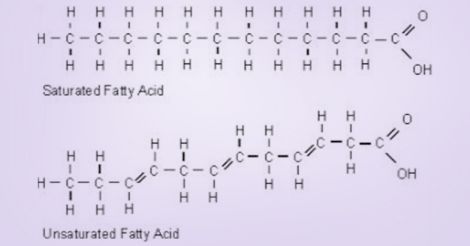 The difference between unsaturated and saturated fatty acids is in the double bonds between carbon atoms. Saturated fatty acids have no double bonds left.
The difference between unsaturated and saturated fatty acids is in the double bonds between carbon atoms. Saturated fatty acids have no double bonds left.Fatty acids with more than one double bond are called polyunsaturated (PUFA), which are seen in sunflower and corn oils, while those with just one are called monounsaturated (MUFA), as in canola or olive oils. Each oil is a mixture of different types of fatty acids.
What is cholesterol?
One of the most fascinating and versatile molecules in the body, cholesterol is a component of our cell membranes, and is the basic platform from which many essential molecules including hormones are manufactured.
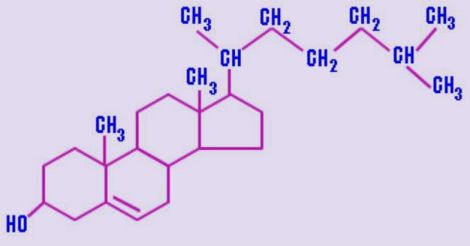 Cholesterol is tetracyclic - with four hydrocarbon rings, to which a hydrocarbon tail and a hydroxyl group is attached.
Cholesterol is tetracyclic - with four hydrocarbon rings, to which a hydrocarbon tail and a hydroxyl group is attached.
Cholesterol is not present in any vegetable oil, and is poorly absorbed from our gut. Most of our body cholesterol is produced in the liver from raw materials such as glucose, fructose and fatty acids. Those who consume sugary foods or fatty meals therefore make more cholesterol. High LDL cholesterol levels are linked with heart disease, while high HDL cholesterol levels are considered protective.
What is omega-6 and omega-3?
This refers to two types of polyunsaturated fats (PUFA) seen in oils. Omega 3 fatty acids have the first double bond located at the 3rd carbon atom when counted from the methyl end of the chain, while omega-6 has it at the 6th carbon atom.
Though both are useful to the body, there is a view that excess omega 6 is not a desirable attribute. The Sydney heart study showed that replacing saturated fats with omega 6 PUFA (Linoleic acid) increased death risk among those with heart disease. Oils that contain the most omega 6 include sunflower oil, safflower and corn oil.
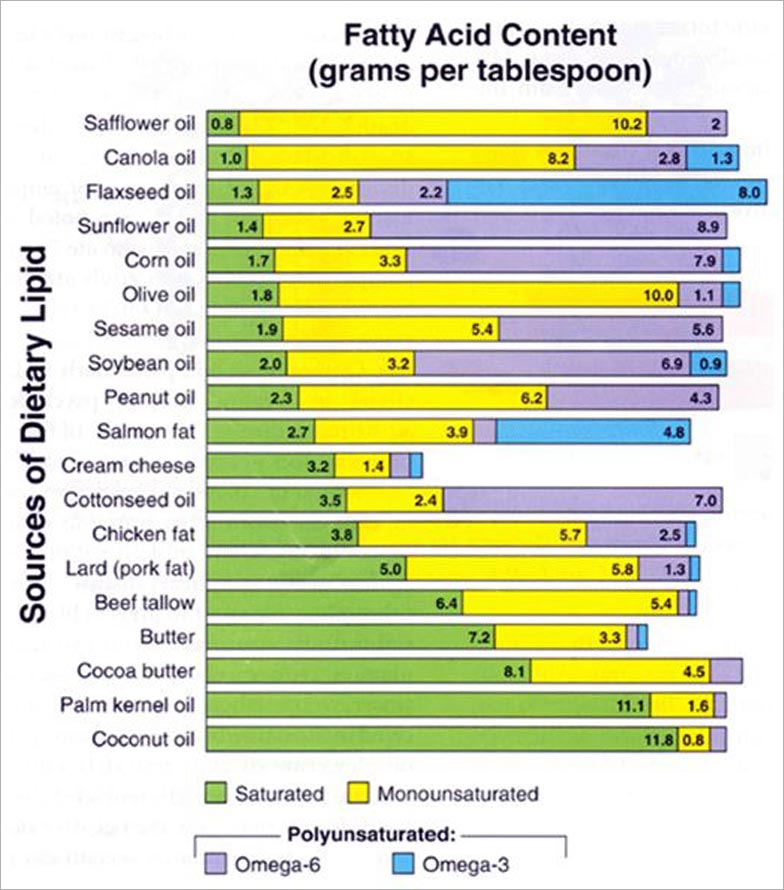 Oils are mixtures of different types of fatty acids: SFA, PUFA and MUFA. Simplistic views of good vs. bad oils are no longer true.
Oils are mixtures of different types of fatty acids: SFA, PUFA and MUFA. Simplistic views of good vs. bad oils are no longer true.
Fish oil supplements were popular a few years ago as they were believed to prevent heart attacks due to omega-3 PUFA content. However, recent research found this to be false.
Why do some oils become rancid?
When exposed to air, light and heat, fats undergo chemical degradation resulting in a foul odour, also called rancidification.
What is hydrogenation of vegetable oil?
When a vegetable oil is subjected to high temperatures in the presence of a catalyst, complete hydrogenation occurs, taking up all the double bonds - making it saturated. In the process, the oil becomes solid and heat-stable.
When only partially hydrogenated, some unsaturated fatty acid carbon chains twist at the double bonds, becoming trans-fats, as the liquid oil turns into spreadable consistency.
 The difference between cis and trans: Cis means that both hydrogen ions are located on the same side of the carbon chain. Trans refers to a change in position, with hydrogen ions on opposing sides of the carbon chain.
The difference between cis and trans: Cis means that both hydrogen ions are located on the same side of the carbon chain. Trans refers to a change in position, with hydrogen ions on opposing sides of the carbon chain.Trans fats are widely used in bakeries and for deep frying. As they are resistant to becoming stale or rancid, they extend the shelf life of the product.
What is smoke point?
Once oil is left on the stove, after a while, as the temperature rises, it starts giving away smoke. This is called smoking point, which varies between oils. The triglycerides first break down to fatty acids and glycerol, and the glycerol breaks down further producing fumes and unhealthy free radicals.
Low smoking point oils such as butter and olive oil cannot be used for high temperature cooking. There are ways such as refining to increase the smoking point and heat-stability of oils, but such methods take away the flavour of the oil. The same oil develops a lower smoking point with repeated use.
What is virgin oil?
When oil is extracted by crushing and pressing of the seeds, it is called virgin oil, also called ‘cold-pressed’ or raw oil, which retains the flavour of the source substance. They are not suited for high temperature cooking, and get rancid quickly. They are best used for salad dressings, flavouring or low-temperature cooking such as sautéing.
In the case of coconut oil, the definition of virgin oil is less clear. Virgin coconut oil is produced from the meat of a freshly opened coconut, and is white in colour. Cold-pressed coconut oil, also commonly referred to as virgin coconut oil, is made from the dried kernel (copra). When refined, it is called RBD coconut oil (refined, bleached and deodorized).
What is refined oil?
Refining is meant to increase the shelf-life and heat stability of the oil. While superficially it might seem a positive attribute, the process of ‘refining’ involves high heat and the use of chemicals. This takes away many of the natural nutrients such as vitamins, antioxidants and removes the natural flavor of the oil.
To extract oil, the seeds are first crushed mechanically. For less ‘juicy’ sources like sunflower seed, solvent extraction using hexane is required to maximize the output. The oil is filtered and neutralized using caustic soda based on free fatty acid content. Further steps such as bleaching, degumming, and dewaxing follow. The final step is deodorisation that involves passing superheated steam in excess of 500 degrees under high pressure.
What is Canola?
Canola is short for ‘Canadian oil’. It is made from genetically modified rapeseed (Brassica) which resembles mustard, seen in expansive bright yellow fields across Canada and Europe. While cold-pressed ‘virgin’ rapeseed oil is popular in Britain, Canola is industrially produced refined rapeseed oil - and is exported worldwide.
What is the difference between palm oil, palmolein and palm kernel oil?

Palm oil is extracted from the mesocarp (husk) of the palm fruit. It is then fractionated into a solid component called palm stearin, and a liquid portion called palmolein. Palm kernel oil, on the other hand, is made from the seed of the palm fruit.
What oils are best?
The single answer to the question is “least is best”, as the present-day diet includes a substantial amount of invisible fat already. For example, nuts, fish, meat, egg, grated coconut and dairy products as part of our diet already contain fat. Hence, any added oil could turn out to be in excess of the daily requirement. There are several choices of oils depending on local availability and marketing penetration.
Unfortunately, much of the available health information available on the internet or social media is of low scientific content and of dubious value to the reader. The topic of medical hoaxes was described in my earlier article.
The indisputable facts are given below, followed by a discussion on the controversial ones.
Indisputable fact # 1
Reheated or recycled oils are harmful. There is concrete evidence that oils that are reheated contain harmful substances that are known to produce high blood pressure, heart disease and cancer. These substances can be the degradation products of the oil or the charred remains of food. Examples of such substances include acrolein, (which is also found in cigarettes and plastics), aldehydes, trans fats, reactive oxygen species and advanced gylcation end products. They are collectively termed NFC or neo-formed contaminants: which means these are new and unwelcome substances that appeared as a result of repeated heating.
Indisputable fact # 2
No single oil is good enough. Each cooking oil is a mixture of saturated, monounsaturated (MUFA) and polyunsaturated fatty acids (PUFA), and the relative amounts of nutritional ingredients vary. Hence, using two or more oils separately is better than using the same oil for every need.
Indisputable fact # 3
Virgin oil is healthier than refined oils. The reason is that it is cold-pressed, and not subjected to high temperatures or chemicals during processing, and retains the natural nutrients and flavor. The downside is that is can spoil easily by oxidation, and is not suited for deep frying.
For salad dressings and low temperature cooking, virgin coconut or olive oils can be used. They are best kept refrigerated in a dark place, to prolong their shelf life.
Indisputable fact # 4
Trans-fats are not heart-healthy. Trans fats, also called partially hydrogenated vegetable oil or vegetable ghee (vanaspathy) are considered more likely than saturated fats to raise LDL cholesterol, lower HDL-C and lead to heart disease. They were banned in several developed countries including Denmark, where heart disease deaths have declined since.
Indisputable fact # 5
Dietary cholesterol is no longer a matter of great concern.
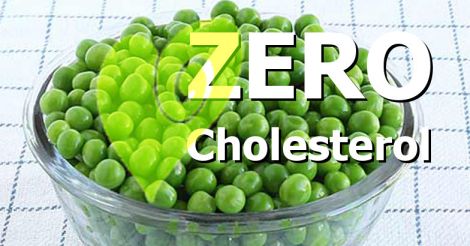 Popular gimmick: misleading labels like this are often found on cooking oils. Being of plant origin, they are not expected to contain cholesterol anyway. Besides, dietary cholesterol intake does not raise blood cholesterol nearly as much as carbohydrates and fatty acids.
Popular gimmick: misleading labels like this are often found on cooking oils. Being of plant origin, they are not expected to contain cholesterol anyway. Besides, dietary cholesterol intake does not raise blood cholesterol nearly as much as carbohydrates and fatty acids.
Unlike saturated fat, intake of cholesterol through food does not significantly raise blood cholesterol. Being a complex molecule very different from traditional fat, cholesterol is not well-absorbed from the gut. This is the reason for the new USDA guidelines stating that egg yolk is safe to eat.
Indisputable fact # 6
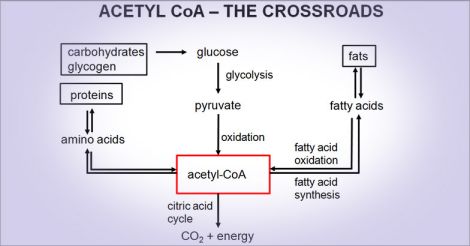 The body manufactures fat from carbohydrates, proteins as well as fatty acids. The versatile Acetyl CoA is the common link between carbohydrate, fat and protein metabolism - it can either be used for energy or be molded into other molecules as needed.
The body manufactures fat from carbohydrates, proteins as well as fatty acids. The versatile Acetyl CoA is the common link between carbohydrate, fat and protein metabolism - it can either be used for energy or be molded into other molecules as needed.Eating fat is not the main reason why people get fat. The body has the ability to manufacture fat from carbohydrates and other sources. When we consume carbohydrates in excess of our energy needs, the surplus gets stored as fat – which incidentally is the most efficient form of fuel storage. In fact more obesity is caused worldwide by excessive intake of refined carbohydrates including sugars, than by consumption of oil.
Controversial topics
Topic #1. Are saturated fats really harmful?
Of greatest interest to all is whether saturated fats are harmful or not. There is a large body of literature - scientific and otherwise, that has created an impression that saturated fats lead to heart disease by raising blood cholesterol levels. Many experts therefore recommend replacing saturated fats in diet with MUFA and PUFA, though this notion has been challenged recently.
It was pure speculation that started this thread in the 1950’s, but the argument that high cholesterol is linked with heart disease and that saturated fats are one of the raw materials for manufacturing cholesterol was too attractive a theory to be discarded. Logic seemed to state that if A is linked with B and B is linked with C, then A must be linked with C.
 Cats may be seen around fish stalls, but they don’t influence fish sales. Statistical association doesn’t imply causation. Mark Twain said: “There are lies, damned lies and then there are statistics”. Photo: Getty images
Cats may be seen around fish stalls, but they don’t influence fish sales. Statistical association doesn’t imply causation. Mark Twain said: “There are lies, damned lies and then there are statistics”. Photo: Getty images
The problem in scientific research is that association does not imply causation in many instances. For example, while studying the pattern of sales in a village market, we may find more cats near the stalls that sell fish, when compared to stalls selling fruit. Though we can report a ‘statistically significant’ association or ‘link’ between the presence of a cat and the sale of fish, we know that the cats do not influence fish sales, and that getting rid of the cats will have no impact on future sales. In other words the ‘link’ was not ‘causative’, and such a study is of no use to anyone.
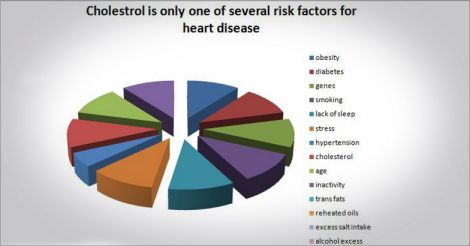 One among many: it is not uncommon to ignore all of the other coronary risk factors due to the excess emphasis placed on cholesterol levels.
One among many: it is not uncommon to ignore all of the other coronary risk factors due to the excess emphasis placed on cholesterol levels.As in the example of the cat and the fish above, the question of whether saturated fat intake or high LDL cholesterol are just linked with heart disease or whether they actually cause heart disease is controversial at this time. It is quite possible that the elevated LDL cholesterol found in patients with heart disease is an incidentally detected by-product or marker of the actual process of atherosclerosis rather than the cause of it. The other known risk factors of atherosclerosis are smoking, age, heredity, diabetes, hypertension, stress, excess alcohol, inadequate sleep, trans fats, excess salt and sugar, lack of exercise and obesity.
Some very controversial research has been published in the British Medical Journal less than a year ago. Known as the MCE or Minnesota Coronary Experiment, it looked at whether replacing saturated fats with vegetable oil would prevent heart disease. The study had been done several decades ago and was complete with information from the autopsies of those who died eventually. However, the results were never published for mysterious reasons, until some contemporary researchers dug up the data and analysed it.
The results were startling: those who switched from saturated fats to vegetable oils had more deaths from heart disease, and the deaths were more among those whose cholesterol levels dropped the most. The reason perhaps the findings were not disclosed was that this was so outrageously out of tune with prevailing opinion. Results of The Sydney Heart study published recently arrived at the same conclusion.
These studies show that our knowledge about the role of diet in heart disease is far from complete, and that heart attacks cannot simply be prevented just by switching from one cooking oil to another.
The traditional sources of saturated fats included meat, milk, nuts, butter and cheeses, which contain other known and unknown nutrients. It is quite possible that those who were forced to switch to vegetable oils as part of the study could have been deprived of these nutrients, which led to the early deaths.
Not all saturated fats are the same
Saturated fats are composed of many different types of fatty acids, which can be short, medium or long-chain type. Among these, the medium chain fatty acids (MCFA) are used differently by the body. Also found in breast milk and frequently used to treat malnourished patients, MCFA’s are absorbed directly from the gut into the blood stream.
Compared to long-chain fatty acids, MCFA’s are preferentially used for energy as they can easily cross the mitochondrial membrane. Mitochondrion is the furnace of the cell, where fatty acids are broken down piece by piece like firewood, generating energy. Consequently, MCFA’s are not stored much - and cause relatively less weight gain. Lauric and Capric acid are examples of MCFA’s. Sources include coconut oil, palm kernel oil and dairy products.
Nature knows best
Milk was originally designed by nature for baby mammals to achieve healthy growth till adulthood. Nuts, fish and meat are fat sources designed for consumption by adult mammals as part of the food chain. It is counterintuitive to believe that such natural products would contain a substance that is harmful - when taken in the right amounts. It is therefore unlikely that the simplistic view ‘all saturated fats are bad’ will last long in the forward timeline of science.
Flawed research from the 1950’s
There is substantial controversy about the original work of Ancel Keys, a physiologist whose ‘Seven Countries study’ from the 1950’s claimed that saturated fats increased heart disease risk. This declaration changed the history of how the world ate afterwards. By claiming that dietary fat caused heart attacks, this study got a lot of public attention and Americans quickly turned to carbs, which unfortunately lead to the current problem of obesity.
The reason why people became obese after switching to carbs is simple. We can’t eat too much of fat as it signals the satiety centre and makes us feel full quickly. On the other hand, carbs such as fructose (a commonly used sweetener) tampers with the satiety centre, keeping us constantly hungry - leading to continuous eating and obesity.
It is now known that though Ancel Keys had data from twenty two countries, he only chose to include those seven whose heart disease patterns suited his hypothesis – which is like tossing a coin with heads on both sides. Data from several countries including France, Switzerland, Sweden and West Germany were not included: the low heart disease risk in these countries despite high fat intake would have neutralized the study’s conclusion.
 This universal truth also applies to medical knowledge, which is increasingly influenced by commercial interests. Many early theories about health and disease have been proven wrong afterwards.
This universal truth also applies to medical knowledge, which is increasingly influenced by commercial interests. Many early theories about health and disease have been proven wrong afterwards.
Verdict: This role of saturated fat in heart disease is a subject of ongoing debate. There has been a softening of the global stand towards saturated fat with recent research suggesting that the harmful effect might have been exaggerated and requires further analysis. While this is not an endorsement to consume unlimited butter and red meat, it can be safely stated that when consumed in the right amounts, saturated fat - in its natural form - has its own beneficial effects on the human body.
Controversial topics # 2: Is coconut oil healthy?
In the past decades when simplistic views of heart disease were prevailing, coconut oil was thought to be a cause for heart disease because of its saturated fat content. However, more recent research has disagreed with this. Recent good quality comparative studies done on patients consuming coconut and sunflower oils showed that the lipid profile was, surprisingly, no different in either group.
It is irrational to assume that all saturated fats have the same effect on the body. Just as looking at tyres alone is not a great way to compare different cars, being saturated or unsaturated is only one attribute of an oil. Attention needs to be paid to other attributes like the lengths of individual fatty acids, the proportion of medium chain fatty acids, the smoke point, the phytonutrients and natural antioxidants, NFC’s, vitamin levels, the omega 3: 6 ratio, the pattern of intended use, the refining process that involves thermal and chemical treatment, the trans fat content, the quantity consumed and many other variables that are yet to be discovered.
A clever study from south India looked at the removed specimens of damaged coronary arteries of people who had severe heart disease and underwent coronary bypass grafting. The plaques that blocked the arteries did not contain any of the fatty acids that were originally present in the coconut or sunflower oils which had been part of their diet.
This study shows that coronary artery disease or heart blocks are not simply a case of ‘excess dietary oil floating around in blood stream getting stuck to the walls of blood vessels’ as is often believed. While the exact cause of heart blocks remains unknown at this time, the wealth of scientific knowledge suggests that inflammation of the blood vessel walls is a key element in the formation of the atherosclerotic plaque, and that much of the fat content in these plaques is in fact produced locally within the walls of the blood vessels as part of this inflammation.
 Society tends to overuse things that are termed ‘good’, and food is no exception.
Society tends to overuse things that are termed ‘good’, and food is no exception. While it is basic human nature to engage in ‘splitting’ which means segregating all things as either good or bad, one must be cautious in extrapolating such information into a blanket statement that “coconut oil is good”. It is prudent to state that in small amounts, coconut oil can be a part of our diet unless compelling research evidence to the contrary is discovered in the future.
Controversial topic #3: Is olive oil heart-healthy?
There is a perception that olive oil is ‘heart-healthy’, which is a product of clever marketing strategy, word-of-mouth and biased interpretation of research. Olive oil is a part of the Mediterranean diet, which involves healthy whole grains, fruit, organic lean meat and fresh vegetables, while avoiding all processed food. This diet is consumed by a non-obese Scandinavian population who lead a physically active lifestyle - who predictably had better health outcomes. The reason why they chose olive oil was because it was locally grown and easily available. The explanation for better health in this group of people is more likely to be the whole package of healthy lifestyle, and not olive oil alone.
Verdict: On its own, olive oil is probably no better or worse than any other locally produced oil. It is not suitable for high temperature cooking. More importantly, it should not be consumed in large quantities under the assumption of being ‘heart-healthy’.
Controversial topic #4: The status of butter and ghee
Just like the case of coconut oil, the fear of saturated fats made a lot of people turn away from butter and ghee, some even turning into margarine or butter substitutes. Unfortunately, it was later discovered that the butter substitutes were harmful due to their trans-fat content.
Ghee is clarified butter. It is made by heating butter, removing the milk solids by filtering and skimming off the foam on top. Ghee is able to withstand high temperatures while cooking. This is not to be confused with vegetable ghee or vanaspathy. While there is a lot of recent worldwide popularity and celebrity endorsements for ghee as cooking oil, scientific literature on its merits and demerits are still scarce.
The advantage of ghee is that it is heat stable, easy to make at home, has a long shelf-life and can be used by those who are lactose intolerant. Unlike refined oils, ghee is free from added chemicals.
Contemporary issues about cooking oils
1. The problem of reused oil
While cooking at home, it is easy to control the quality of oil used, and to discard oil that has been once used for high heat cooking. However, it is a common observation in commercial food establishments that the same oil gets reused for deep-frying.
Of particular concern is the popularity of deep fried snacks in India. It is common to see an iron cauldron of oil being used to deep fry chips, samosas, chicken, fish, banana fritters and vadas. At the start of the day, the cauldron might have 20 litres of oil. However by the end of the day, the oil level drops. Instead of replacing the whole cauldron of oil the next day, it works out cheaper for the vendor to top up the level using fresh oil, thus creating a mixture of old and new oil. This process gets repeated over days, which means that at any given time, there will be some oil in the cauldron that has been reused dozens of times.
Recent sting operations by media in Kerala have uncovered unscrupulous vendors repeatedly using the same stale oil for frying snacks before packaging for distribution to outlets. Illegal recycling of discarded cooking oil is reported in China, also called ‘gutter oil’ where miscreants dredge gutters for discarded oil and sell it to street food vendors.
2. The problem of adulteration
Adulteration of cooking oil has been reported worldwide. In south India, coconut oil is produced from the dried kernel of coconut, and is ideally made cold-pressed. Unlike imported cooking oils that are industrially produced in large scale, the manufacture of coconut oil in India is relatively expensive and labour intensive. It is therefore convenient to adulterate pure coconut oil with cheaper oils such as palmolein. Purity is verified by checking the refractory index of the oil, which can in fact be manipulated by the adulterer to match that of pure coconut oil. Recent news reports of coconut oil adulterated with paraffin oil and palm kernel oil being smuggled into Kerala and sold during festive seasons are of concern.
In India, mixing of oils is permissible only under license by FSSAI or AGMARK. Unscientific and unauthorised mixing results in oils of different smoking points being present in the same mixture, and can therefore be injurious to health.
Summary
1. Fats and cholesterol have an essential role in the normal structure and function of the human body. Adequate intake of fat is healthy, while excess is harmful.
2. Dietary fat is not the only source of cholesterol in the body. A large portion of the cholesterol in the body is manufactured from carbohydrates.
3. Much of the circulating information about cooking oils is of poor scientific content, and largely based on individual or commercial interest. Public perception of ‘heart healthy’ or ‘unhealthy’ oils is heavily influenced by hearsay and clever advertising.
4. Scientific literature has not been consistent in deciding about the relative merits of saturated fats, MUFA or PUFA. The ideal ratio of the three is still not clear.
5. Not all saturated fats are the same. Fats containing medium-chain fatty acids are considered healthier than those with long-chain fatty acids.
6. The less oil, the better. Oils are calorie-dense, and must be used sparingly. Many foods that we eat already contain invisible fat; hence the use of any additional oil is best minimised. Thus, the tendency to pour olive oil over salads ‘because it is heart healthy’ makes no sense. Fat-free dressings (such as vinaigrette) are the heart-healthy option.
7. No single oil has clear superiority over another at this time. When choosing oil type, a good strategy is to use ‘oil of the soil’, which means to use the natural produce that is locally available in the region.
8. Using more than one oil in small amounts is helpful to maintain a balanced essential fatty acid intake.
9. Rather than deep frying, healthier choices would be to bake, steam, boil, grill or stir fry with minimum oil on non-stick cookware.
10. Cold-pressed and virgin oils contain natural nutrients that are lost by the process of refining.
11. Buying from a local source we can trust is a practical way to ensure the purity of the oil.
12. Reheating and reusing of oils is harmful and is to be avoided.
13. Staying away from deep-fried snacks made in unknown locations is a sensible thing to do, as the oil could have been used numerous times.
14. The tag ‘vegetable origin’ or ‘zero cholesterol’ confers no real health advantage to oils.
15. Trans-fats lead to heart disease. The words ‘partially hydrogenated’ on the label indicate the presence of trans-fats.
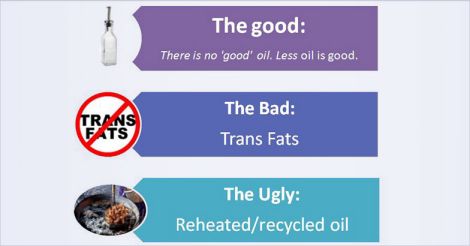
16. Illnesses like cancer and heart disease have only been incompletely understood. Attempts to oversimplify and compartmentalise health, diet and disease without good-quality evidence may seem initially appealing, but will eventually be proved wrong. As has consistently happened, diligent research in the future will change many of the accepted norms of today.
Further reading
4. Short- and medium-chain fatty acids in energy metabolism: the cellular perspective. Peter Schönfeld, Lech Wojtczak, Journal of Lipid Research Volume 57, 2016
5. There are thousands of types of fat molecules in the body
8. LCT causes more weight gain than MCT; metabolism of MCT and LCT are different
9. Medium chain fatty acids have similar effects on lipid profile as olive oil
10. Blend of oils produced better lipid profile
11. Coronary plaques no different among coconut or sunflower oil users
12. Sunflower oil and coconut oil produce the same lipid profile
13. Why doctors’ knowledge could be corrupted by wrong interpretations and manipulating of statistics

























